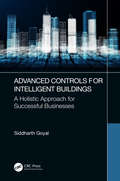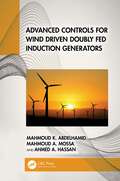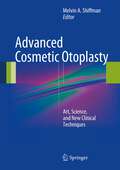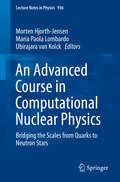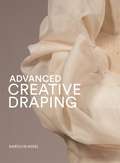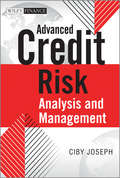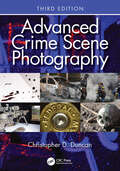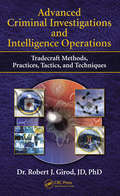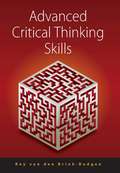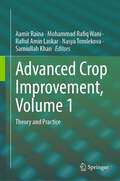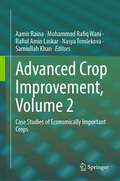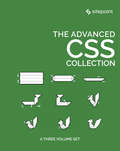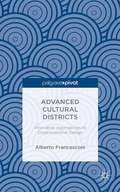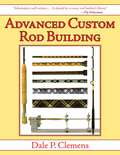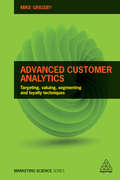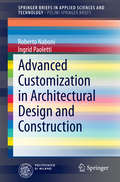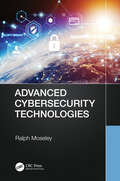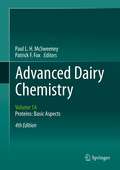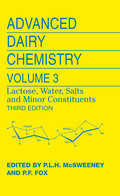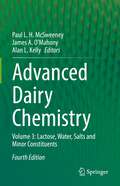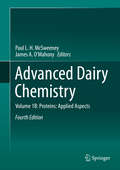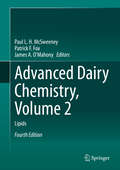- Table View
- List View
Advanced Controls for Intelligent Buildings: A Holistic Approach for Successful Businesses
by Siddharth GoyalThis book focuses primarily on both technical and business aspects needed to select, design, develop and deploy control application (or product) successfully for multiple components in building systems. Designing and deploying a control application require multiple steps such as sensing, system dynamics modelling, algorithms, and testing. This may involve choosing an appropriate methodology and technique at multiple stages during the development process. Understanding the pros and cons of such techniques, most importantly being aware of practically possible approaches in the entire ecosystem, is critical in choosing the best framework and system application for different parts of building systems. Providing a wide overview of the state-of art in controls and building systems, providing guidance on developing an end-to-end system in relation to business fundamentals (distribution channels, stakeholders, marketing, supply-chain and financial management), the book is ideal for fourth-year control/mechanical/electrical engineering undergraduates, graduate students, and practitioners including business leaders concerned with smart building technology.
Advanced Controls for Wind Driven Doubly Fed Induction Generators
by Mahmoud K. Abdelhamid Mahmoud A. Mossa Ahmed A. HassanAdvanced Controls for Wind Driven Doubly Fed Induction Generators discusses the most advanced control algorithms used for enhancing the dynamics of a doubly fed induction generator (DFIG) operating at fixed and variable speeds, and which are used for different utilization purposes (standalone and grid connection). Extensive generator performance analysis has been introduced using various control topologies. Features: Presents modeling of wind energy conversion systems (WECS), including a wind turbine as a prime mover, a DFIG as a generation unit for electrical energy, and a three-phase induction motor as an isolated load Explores a detailed description for the presented control algorithms in order to visualize the base principle of each method Introduces a comprehensive performance analysis for the DFIG using the formulated predictive voltage control scheme and other control techniques under different operating conditions Examines the formulation of new control approaches which overcome the shortages present in previous DFIG control schemes Presents a detailed comparison between different control topologies for the DFIG to outline the most effective procedure in terms of dynamic response, structure simplicity, ripples, total harmonic distortion, and computational burdens The book is written for researchers and academics working on advanced control systems and those interested in areas such as machine drives, renewable energy systems, 'adaptive control', modeling of WECS, and optimization theory.
Advanced Cosmetic Otoplasty: Art, Science, and New Clinical Techniques
by Melvin A. ShiffmanIn this book, international experts present up-to-date techniques of otoplasty in which they have extensive personal experience. Both new and modified procedures are described with the aid of a wealth of high-quality illustrations. In addition to these detailed descriptions, ear embryology and anatomy, psychological issues, postoperative care, possible risks and complications, and outcomes are extensively covered in order to provide the reader with a state of the art account of all aspects of cosmetic otoplasty. Throughout, the contributors are inventive and eloquent in guiding the reader to a better understanding that optimal results of otoplasty will be achieved only with a more refined approach than the routine use of simplified techniques. This book will be of value to both students (residents and fellows) and experienced cosmetic, plastic, maxillofacial, and general surgeons.
Advanced Country Experiences with Capital Account Liberalization
by International Monetary FundThis paper considers how capital markets in developing and transition economies can best be liberalised by reviewing the lessons learned from the experiences of advanced industrialised countries in opening up their capital markets in the years following the Second World War.
An Advanced Course in Computational Nuclear Physics: Bridging the Scales from Quarks to Neutron Stars (Lecture Notes in Physics #936)
by Morten Hjorth-Jensen Maria Paola Lombardo Ubirajara Van KolckThis graduate-level text collects and synthesizes a series of ten lectures on the nuclear quantum many-body problem. Starting from our current understanding of the underlying forces, it presents recent advances within the field of lattice quantum chromodynamics before going on to discuss effective field theories, central many-body methods like Monte Carlo methods, coupled cluster theories, the similarity renormalization group approach, Green's function methods and large-scale diagonalization approaches. Algorithmic and computational advances show particular promise for breakthroughs in predictive power, including proper error estimates, a better understanding of the underlying effective degrees of freedom and of the respective forces at play. Enabled by recent improvements in theoretical, experimental and numerical techniques, the state-of-the art applications considered in this volume span the entire range, from our smallest components - quarks and gluons as the mediators of the strong force - to the computation of the equation of state for neutron star matter. The lectures presented provide an in-depth exposition of the underlying theoretical and algorithmic approaches as well details of the numerical implementation of the methods discussed. Several also include links to numerical software and benchmark calculations, which readers can use to develop their own programs for tackling challenging nuclear many-body problems.
Advanced Creative Draping
by Karolyn KiiselAdvanced Creative Draping teaches designers and students how to drape fashion-forward, conceptual designs that use elements of couture construction to elevate the work to the highest level of fashion. Five methods of draping are explored as well as draping using embellishments or particular surface designs. The final chapter demonstrates how to create a high quality heirloom garment. Featuring specially commissioned step-by-step photography, the book includes tips from designers working with draping methods today. Essentially an advanced textbook for the serious fashion student, it also serves as a workroom reference book for professional fashion and costume designers.
Advanced Creative Draping
by Karolyn KiiselAdvanced Creative Draping teaches designers and students how to drape fashion-forward, conceptual designs that use elements of couture construction to elevate the work to the highest level of fashion. Five methods of draping are explored as well as draping using embellishments or particular surface designs. The final chapter demonstrates how to create a high quality heirloom garment. Featuring specially commissioned step-by-step photography, the book includes tips from designers working with draping methods today. Essentially an advanced textbook for the serious fashion student, it also serves as a workroom reference book for professional fashion and costume designers.
Advanced Credit Risk Analysis and Management
by Ciby JosephCredit is essential in the modern world and creates wealth, provided it is used wisely. The Global Credit Crisis during 2008/2009 has shown that sound understanding of underlying credit risk is crucial. If credit freezes, almost every activity in the economy is affected. The best way to utilize credit and get results is to understand credit risk.Advanced Credit Risk Analysis and Management helps the reader to understand the various nuances of credit risk. It discusses various techniques to measure, analyze and manage credit risk for both lenders and borrowers. The book begins by defining what credit is and its advantages and disadvantages, the causes of credit risk, a brief historical overview of credit risk analysis and the strategic importance of credit risk in institutions that rely on claims or debtors. The book then details various techniques to study the entity level credit risks, including portfolio level credit risks.Authored by a credit expert with two decades of experience in corporate finance and corporate credit risk, the book discusses the macroeconomic, industry and financial analysis for the study of credit risk. It covers credit risk grading and explains concepts including PD, EAD and LGD. It also highlights the distinction with equity risks and touches on credit risk pricing and the importance of credit risk in Basel Accords I, II and III. The two most common credit risks, project finance credit risk and working capital credit risk, are covered in detail with illustrations. The role of diversification and credit derivatives in credit portfolio management is considered. It also reflects on how the credit crisis develops in an economy by referring to the bubble formation. The book links with the 2008/2009 credit crisis and carries out an interesting discussion on how the credit crisis may have been avoided by following the fundamentals or principles of credit risk analysis and management.The book is essential for both lenders and borrowers. Containing case studies adapted from real life examples and exercises, this important text is practical, topical and challenging. It is useful for a wide spectrum of academics and practitioners in credit risk and anyone interested in commercial and corporate credit and related products.
Advanced Crime Scene Photography
by Christopher D. DuncanThe ability to thoroughly and accurately photograph a crime scene is a mandate for all investigators, regardless of the time of day, weather conditions, or confines within which a piece of evidence is concealed. Evidence is commonly found in locations that are some of the most difficult to access and photograph. Having the knowledge, wherewithal, and skills necessary to photograph evidence in less-than-accommodating environments is vital to a photographer’s effectiveness and success. Advanced Crime Scene Photography, Third Edition takes a somewhat different approach to the subject over prior editions. Rather than assuming a crime scene investigator’s or photographer’s comfort with the operation of their cameras—and a basic understanding of apertures, shutter speeds, ISO values, and basic exposure calculations—the author has added coverage to provide a thorough review of basic photographic concepts, as a refresher to readers. And, for those less familiar or otherwise new to photography, such background makes the foundational concepts more understandable for those readers who require such information to understand the more advanced techniques covered later in the book. In addition to this background coverage, an entirely new chapter has been added to provide essential guidance on how to prepare and testify in court. Anyone with a camera phone can take a photograph in perfect lighting, with the subject sitting out in the open, and already positioned for the best composition. This book provides crime scene photographers with the skills necessary to record those same beautiful photographs in adverse condition, surrounded by tragedy, utilizing all the tools available to the investigator. The greatest tool a photographer has available to them is their brain. From start to finish, the value of quality crime scene photographs cannot be overemphasized; photographers must take control of their photographic endeavors, identify the challenges, design a plan to capture the image correctly, and then execute that plan. As such Advanced Crime Scene Photograph, Third Edition is written to help photographers achieve the goal of capturing the best possible images—especially in those difficult-to-capture, real-world environments and conditions—for utilization in capture illustrative images as admissible evidence and for usage in court. All photographers need to practice their craft, whether they are actively working cases as seasoned veterans or are just beginning their careers. This book provides the knowledge and skills essential to achieve career and professional success in crime scene photography.
Advanced Criminal Investigations and Intelligence Operations: Tradecraft Methods, Practices, Tactics, and Techniques
by Robert J GirodTradecraft is a term used within the intelligence community to describe the methods, practices, and techniques used in espionage and clandestine investigations. Whether the practitioner is a covert agent for the government or an identity thief and con man, the methods, practices, tactics, and techniques are often the same and sometimes learned from
Advanced Critical Thinking Skills
by Roy Van Den Brink-BudgenThis book takes the skills introduced in Roy van den Brink-Budgen's bestselling book Critical Thinking for Students and extends and builds on them. As a result, it will be especially useful for students on advanced level courses, whether in schools, colleges, or universities. It shows how complex arguments can be built up, analysed, and evaluated. It also shows how the use of various types of claim can be approached in argument, by stressing the need to ask a series of questions about their possible significance. The frequent role of explanation in the drawing of inference is also detailed. In addition, it applies Critical Thinking skills to decision-making, showing how these skills can clarify the choices available, their possible consequences, and the criteria needed to make decisions. In short, this book shows how to become an even more active and effective Critical Thinker.
Advanced Critical Thinking Skills
by Roy Van Den Brink-BudgenThis book takes the skills introduced in Roy van den Brink-Budgen's bestselling book Critical Thinking for Students and extends and builds on them. As a result, it will be especially useful for students on advanced level courses, whether in schools, colleges, or universities. It shows how complex arguments can be built up, analysed, and evaluated. It also shows how the use of various types of claim can be approached in argument, by stressing the need to ask a series of questions about their possible significance. The frequent role of explanation in the drawing of inference is also detailed. In addition, it applies Critical Thinking skills to decision-making, showing how these skills can clarify the choices available, their possible consequences, and the criteria needed to make decisions. In short, this book shows how to become an even more active and effective Critical Thinker.
Advanced Crop Improvement, Volume 1: Theory and Practice
by Aamir Raina Mohammad Rafiq Wani Rafiul Amin Laskar Nasya Tomlekova Samiullah KhanAs per the reports of FAO, the human population will rise to 9 billion by the end of 2050 and 70% of more food must be produced over the next three decades to feed the additional population. The breeding approaches for crop improvement programs are dependent on the availability and accessibility of genetic variation, either spontaneous or induced by the mutagens. Plant breeders, agronomists, and geneticists are under constant pressure to expand food production by employing innovative breeding strategies to enhance yield, adaptability, nutrition, resistance to biotic and abiotic stresses. In conventional breeding approaches, introgression of genes in crop varieties is laborious and time-consuming. Nowadays, new innovative plant breeding techniques such as molecular breeding and plant biotechnology, supplement the traditional breeding approaches to achieve the desired goals of enhanced food production. With the advent of recent molecular tools like genomics, transgenics, molecular marker-assisted back-crossing, TILLING, Eco-TILLING, gene editing, CRISPR CAS, non-targeted protein abundant comparative proteomics, genome wide association studies have made possible mapping of important QTLs, insertion of transgenes, reduction of linkage drags, and manipulation of genome. In general, conventional and modern plant breeding approaches would be strategically ideal for developing new elite crop varieties to meet the feeding requirement of the increasing world population.This book highlights the latest progress in the field of plant breeding, and their applicability in crop improvement. The basic concept of this 2-volume work is to assess the use of modern breeding strategies in supplementing conventional breeding toward the development of elite crop varieties, for obtaining desired goals of food production.
Advanced Crop Improvement, Volume 2: Case Studies of Economically Important Crops
by Aamir Raina Mohammad Rafiq Wani Rafiul Amin Laskar Nasya Tomlekova Samiullah KhanAs per the reports of FAO, the human population will rise to 9 billion by the end of 2050 and 70% of more food must be produced over the next three decades to feed the additional population. The breeding approaches for crop improvement programs are dependent on the availability and accessibility of genetic variation, either spontaneous or induced by the mutagens. Plant breeders, agronomists, and geneticists are under constant pressure to expand food production by employing innovative breeding strategies to enhance yield, adaptability, nutrition, resistance to biotic and abiotic stresses. In conventional breeding approaches, introgression of genes in crop varieties is laborious and time-consuming. Nowadays, new innovative plant breeding techniques such as molecular breeding and plant biotechnology, supplement the traditional breeding approaches to achieve the desired goals of enhanced food production. With the advent of recent molecular tools like genomics, transgenics, molecular marker-assisted back-crossing, TILLING, Eco-TILLING, gene editing, CRISPR CAS, non-targeted protein abundant comparative proteomics, genome wide association studies have made possible mapping of important QTLs, insertion of transgenes, reduction of linkage drags, and manipulation of genome. In general, conventional and modern plant breeding approaches would be strategically ideal for developing new elite crop varieties to meet the feeding requirement of the increasing world population.This book highlights the latest progress in the field of plant breeding, and their applicability in crop improvement. The basic concept of this 2-volume work is to assess the use of modern breeding strategies in supplementing the conventional breeding toward the development of elite crop varieties, for obtaining desired goals of food production.
The Advanced CSS Collection
by Craig Buckler Ilya Bodrov-Krukowski Claudio Ribeiro Tiffany B Brown David Attard Ahmed Bouchefra Giulio Mainardi Diego SouzaCSS has grown from a language for formatting documents into a robust language for designing web applications. Its syntax is easy to learn, making CSS a great entry point for those new to programming. Indeed, it's often the second language that developers learn, right behind HTML. As CSS's feature set and abilities have grown, so has its depth. In this collection of books, we'll be exploring some of the amazing things that developers can do with CSS today; tasks that in the past might only have been achievable with some pretty complex JavaScript, if at all. This collection contains: Modern CSS, which explores topics like variable fonts and transforms, and shows how they might be used in the real worldCSS Grid Layout: 5 Practical Projects, which shows five complete projects that utilize the Grid Layout Layout moduleCSS Tools & Skills which looks at essential CSS tools and skills for modern front-end developers
Advanced Cultural Districts: Innovative Approaches to Organizational Design
by Alberto FrancesconiAdvanced Cultural Districts explores the organisational design issues within the cultural heritage sector, with particular focus on the advanced forms of cultural districts for local socio-economic development. Covering eight Italian case studies, most of the literature concentrates on urban clusters, cities of art and cities of culture, intended for local socio-economic development. The book aims to extend the knowledge and understanding of cultural heritage under a managerial and, in particular, organizational perspective. Our arguments intend to support a more conscious and sustainable way of cultural districtualisation as a form to support the local socio-economic development.
Advanced Custom Rod Building
by Dale P. ClemensConsidered the Bible of rod buildingEssential guide for fishermen making their own rodsEspecially useful for the experienced custom builder Have you ever wondered what it would feel like to have a rod that feels like a part of you and not just a tool? Have you ever wanted to make your own fishing rod that rivals those in stores? If you answered “yes” to either question, this book is absolutely for you. Dale P. Clemens encourages all fishermen to have a rod that is specifically customized for his or her style. Advanced Custom Rod Building is the guide you need to make your own. This guide highlights the key points needed to make tackle that is better than anything that could be bought in a store. It also includes clear illustrations, figures, and tables to help the experienced custom builder. Clemens shares techniques for building rods used in all conditions, whether light freshwater or heavy surf. Thanks to this book, building your own custom rod that will be beautiful and durable isn’t a mystery. Skyhorse Publishing is proud to publish a broad range of books for fishermen. Our books for anglers include titles that focus on fly fishing, bait fishing, fly-casting, spin casting, deep sea fishing, and surf fishing. Our books offer both practical advice on tackle, techniques, knots, and more, as well as lyrical prose on fishing for bass, trout, salmon, crappie, baitfish, catfish, and more. While not every title we publish becomes a New York Times bestseller or a national bestseller, we are committed to publishing books on subjects that are sometimes overlooked by other publishers and to authors whose work might not otherwise find a home.
Advanced Customer Analytics
by Mike GrigsbyAdvanced Customer Analytics provides a clear guide to the specific analytical challenges faced by the retail sector. The book covers the nature and scale of data obtained in transactions, relative proximity to the consumer and the need to monitor customer behaviour across multiple channels. The book advocates a category management approach, taking into account the need to understand the consumer mindset through elasticity modelling and discount strategies, as well as targeted marketing and loyalty design. A practical, no-nonsense approach to complex scenarios is taken throughout, breaking down tasks into easily digestible steps. The use of a fictional retail analyst 'Scott' helps to provide accessible examples of practice. Advanced Customer Analytics does not skirt around the complexities of this subject but offers conceptual support to steer retail marketers towards making the right choices for analysing their data.
Advanced Customization in Architectural Design and Construction (SpringerBriefs in Applied Sciences and Technology)
by Roberto Naboni Ingrid PaolettiThis book presents the state of the art in advanced customization within the sector of architectural design and construction, explaining important new technologies that are boosting design, product and process innovation and identifying the challenges to be confronted as we move toward a mass customization construction industry. Advanced machinery and software integration are discussed, as well as an overview of the manufacturing techniques offered through digital methods that are acquiring particular significance within the field of digital architecture. CNC machining, Robotic Fabrication, and Additive Manufacturing processes are all clearly explained, highlighting their ability to produce personalized architectural forms and unique construction components. Cutting-edge case studies in digitally fabricated architectural realizations are described and, looking towards the future, a new model of 100% customized architecture for design and construction is presented. The book is an excellent guide to the profound revolution taking place within the fields of architectural design and construction, characterized by computational tools, advanced fabrication means and custom-made high-performance architecture.
Advanced Cybersecurity Technologies
by Ralph MoseleyCybersecurity is an extremely important area which is rapidly evolving, necessarily, to meet current and future threats. Anyone who studies within this domain requires a particular skillset and way of thinking, balancing technical knowledge and human insight. It is vital to recognize both sides of this complex area and integrate the two. This book looks at the technical fields progressively, building up in layers before expanding into more advanced topics. Each area is looked at succinctly, describing the main elements and problems in each area and reinforcing these concepts with practical coding examples, questions and ideas for further research. The book builds on an overview of basic architecture of systems and networks, setting a context for how information is vulnerable. Cryptography is explained in detail with examples, showing the steady progress in this area over time through to the possibilities of quantum encryption. Steganography is also explained, showing how this can be used in a modern-day context through multimedia and even Virtual Reality. A large section of the book is given to the technical side of hacking, how such attacks occur, how they can be avoided and what to do after there has been an intrusion of some description. Cyber countermeasures are explored, along with automated systems of defense, whether created by the programmer or through firewalls and suchlike. The human aspect of cyber security is detailed along with the psychology and motivations for launching attacks. Social engineering is focused on and with the various techniques looked at – revealing how an informed individual, organization or workplace can protect themselves against incursions and breaches. Finally, there is a look the latest developments in the field, and how systems, such as the IoT are being protected. The book is intended for advanced undergraduate and postgraduate courses on cybersecurity but is also useful for those studying IT or Computer Science more generally.
Advanced Dairy Chemistry: Volume 1A: Proteins: Basic Aspects, 4th Edition
by Patrick F. Fox Paul L. McsweeneyProfessor Fox’s multi-volume Advanced Dairy Chemistry set was first published in four volumes in the early 1980s. A second edition came out in the early 1990s, and an updated third edition was published a decade later. The set is the leading major reference on dairy chemistry, providing in-depth coverage of milk proteins, lipids, and lactose. The editors propose beginning the revision cycle again, with a revised first volume on proteins, to be divided and published separately as Volume 1A - Proteins: Basics Aspects, and Volume 1B – Applied Aspects. Fox and his co-editor, Paul McSweeney, have created an extensively revised the Table of Contents for Volume 1A, which details the novel and updated chapters to be included in this upcoming fourth edition. New contributors include highly regarded dairy scientists and scholars from around the world.
Advanced Dairy Chemistry: Volume 3: Lactose, Water, Salts and Minor Constituents
by Paul L. McSweeney Patrick F. FoxThe Advanced Dairy Chemistry series was first published in four volumes in the 1980s (under the title Developments in Dairy Chemistry) and revised in three volumes in the 1990s. The series is the leading reference source on dairy chemistry, providing in-depth coverage of milk proteins, lipids, lactose, water and minor constituents. Advanced Dairy Chemistry Volume 3: Lactose, Water, Salts, and Minor Constituents, Third Edition, reviews the extensive literature on lactose and its significance in milk products. This volume also reviews the literature on milk salts, vitamins, milk flavors and off-flavors and the behaviour of water in dairy products. Most topics covered in the second edition are retained in the current edition, which has been updated and expanded considerably. New chapters cover chemically and enzymatically prepared derivatives of lactose and oligosaccharides indigenous to milk. P.L.H. McSweeney Ph.D. is Associate Professor of Food Chemistry and P.F. Fox Ph.D., D.Sc. is Professor Emeritus of Food Chemistry at University College, Cork, Ireland.
Advanced Dairy Chemistry: Volume 3: Lactose, Water, Salts and Minor Constituents
by Paul L. H. McSweeney James A. O’Mahony Alan L. KellyThe Advanced Dairy Chemistry series was first published in four volumes in the 1980s (under the title Developments in Dairy Chemistry) and revised in three volumes in the late 1990s and again in the 2000s and 2010s. For nearly four decades, the series has been the leading reference source on dairy chemistry and is now in its fourth edition. Advanced Dairy Chemistry Volume 3: Lactose, Water, Salts, and Minor Constituents, fourth edition, reviews the extensive literature on lactose and its significance in milk products. This volume also reviews the literature on milk salts, vitamins, and the behaviour of water in dairy products and the physical properties of milk. Most topics covered in the third edition are retained in the current edition, which has been updated and expanded considerably. New chapters cover chemically and enzymatically prepared derivatives of lactose and oligosaccharides indigenous to milk and some chapters from earlier editions are consolidated.
Advanced Dairy Chemistry: Volume 1B: Proteins: Applied Aspects
by Paul L. Mcsweeney James A. O'MahonyThe chemistry and physico-chemical properties of milk proteins are perhaps the largest and most rapidly evolving major areas in dairy chemistry. Advanced Dairy Chemistry-1B: Proteins: Applied Aspects covers the applied, technologically-focused chemical aspects of dairy proteins, the most commercially valuable constituents of milk. This fourth edition contains most chapters in the third edition on applied aspects of dairy proteins. The original chapter on production and utilization of functional milk proteins has been split into two new chapters focusing on casein- and whey-based ingredients separately by new authors. The chapters on denaturation, aggregation and gelation of whey proteins (Chapter 6), heat stability of milk (Chapter 7) and protein stability in sterilised milk (Chapter 10) have been revised and expanded considerably by new authors and new chapters have been included on rehydration properties of dairy protein powders (Chapter 4) and sensory properties of dairy protein ingredients (Chapter 8). This authoritative work describes current knowledge on the applied and technologically-focused chemistry and physico-chemical aspects of milk proteins and will be very valuable to dairy scientists, chemists, technologists and others working in dairy research or in the dairy industry.
Advanced Dairy Chemistry, Volume 2: Lipids
by Paul L. H. McSweeney Patrick F. Fox James A. O’MahonyThe Advanced Dairy Chemistry series was first published in four volumes in the 1980s (under the title Developments in Dairy Chemistry) and revised in three volumes in the 1990s and 2000s. The series is the leading reference on dairy chemistry, providing in-depth coverage of milk proteins, lipids, lactose, water and minor constituents.Advanced Dairy Chemistry Volume 2: Lipids, Fourth Edition, is unique in the literature on milk lipids, a broad field that encompasses a diverse range of topics, including synthesis of fatty acids and acylglycerols, compounds associated with the milk fat fraction, analytical aspects, behavior of lipids during processing and their effect on product characteristics, product defects arising from lipolysis and oxidation of lipids, as well as nutritional significance of milk lipids.In the years since the publication of the third edition there have been significant developments in milk lipids and these are reflected in changes to this volume. Most topics included in the third edition are retained in the current edition, which has been updated; in some cases, new authors have given their perspective on certain topics. Chapters on nutritional significance of dairy lipids have been considerably revised.This authoritative work summarizes current knowledge on milk lipids and suggests areas for further work. It will be very valuable to dairy scientists, chemists and others working in dairy research or in the dairy industry.
